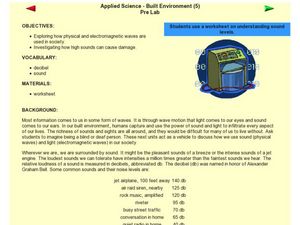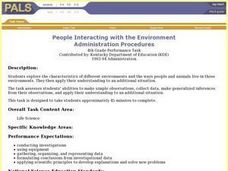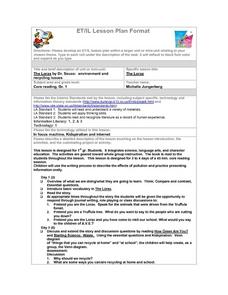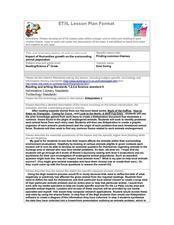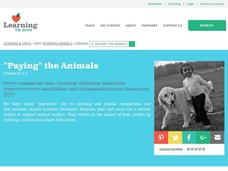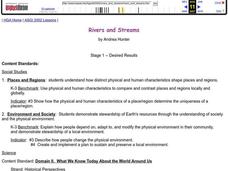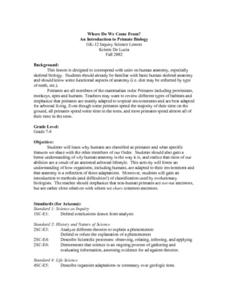Curated OER
Ecology
Learners gain an understanding of necessary components required within a healthy, sustainable environment and ways human actions can impact that balance while discovering how to recognize and analyze explanations and models used in...
Curated OER
Global Carbon Cycle
Pupils, in groups, create posters of the flow of a carbon atom as it travels through the carbon cycle. They make connections about how human activities affect the carbon cycle, as well.
Curated OER
Recycled Treasures
Students develop creative-thinking skills that they will use repeatedly throughout their life. In this early childhood art lesson, students develop creative-thinking, social-development, and language skills, and an awareness of the...
Curated OER
Applied Science - Built Environment (5) Pre Lab
Fifth graders look at the impact of sound and noise. In this sound lesson, 5th graders review the decibel and common sounds along with their noise levels. They complete a worksheet about the different sounds that one might hear during...
Curated OER
Air and Water in the Environment
Students demonstrate an awareness of air as a substance that surrounds us and takes up space, and whose movement we feel as wind. They predict and describe how local weather conditions affect living things, including themselves.
Curated OER
People Interacting with the Environment
Students explore an arctic, temperate, and tropical environment and then decide what people need in each environment to help them live comfortably and what their lives would be like.
Curated OER
Environment
Students examine the energy saving benefits of trees. They identify ways in which trees reduce air pollution. They also work together to solve problems related to pollution.
Curated OER
The Human Organism
Eighth graders investigate animal behavior by studying the lives of three female behavior scientists. In this human organism lesson students do different activities that inquire and approach each females work.
Curated OER
Environment and Recycling Issues
First graders read and understand the text found while conducting internet research. They recognize how literature records information and reflects the human experience. Students also compare and contrast answers to questions. Then...
Curated OER
Impace of Humanities growth on the Surrounding Animal Population
Fourth graders read books about endangered animals. Using Kidspiration software, 4th graders create a presentation illustrating the plight of endangered animals. They identify problems, develop a graphic organizer, and explain the origin...
Curated OER
Creating Artwork to Explain Environmental Change
High schoolers review artwork that relates to the environment and communicates a value. They view and analyze art by Andy Warhol, Eric Carle and Albert Bierstadt and then create original pieces with an environmental theme.
Curated OER
Working Animals
Students examine the need for the humane treatment of animals. In this animal welfare lesson, students realize the need for animal welfare, and decide on a service project that will promote it. The lesson culminates in the creation of a...
Curated OER
Designs for Urban Life
Students analyze the design of cities and systems as an architecture analysis. For this architecture analysis lesson, students complete image based discussion and two related activities for the lesson.
Curated OER
Importance of Digestion
In this digestion worksheet, students complete statements using researched information about digestion and the digestive system. Students also sketch several figures that relate to digestion.
Curated OER
Consider The Source
Students learn about the largest natural and human sources of air pollution to become aware of these components in their surrounding environment. In this environmental lesson, students read and describe natural sources of air pollution....
Curated OER
Flowering Phenology: How Do Plants Know When to Flower?
Students study the process of plant reproduction and the biotic and abiotic factors that affect flowering phenology. In this plant reproduction lesson, students describe the interaction of environmental factors as it relates to...
Curated OER
Organ System Interactions
Eighth graders who have studied all of the organ systems now discover how they all are related and work together in the human body. They discuss a variety of situations in which more than one system plays a part. They identify the...
Curated OER
Questions regarding the Digestive System
In this science related worksheet, students locate and answer thirty three multiple choice questions regarding the digestive system in humans.
Curated OER
Healthy Hearts
Students research the basic concepts of heart health and disease and become an expert in an area as it relates to the heart and circulatory system. They prepare a multimedia presentation of their findings.
Curated OER
Acid Rain
Create a simulation of acid rain in your classroom with lemon juice and bean plants to help kids study the effects of pollution on plants. In addition, learners will listen to a story and write responses based on guiding questions.
Carnegie Mellon University
Transportation
Teach your environmental studies, life science, or engineering class how an internal combustion engine works using the first few slides of the accompanying presentation. Then, focus in on the resulting carbon emissions. Finally, take a...
Curated OER
Monoculture and Polyculture
Ecology explorers collect soil and invertebrates from a monoculture and a polyculture area. They relate the number and types of invertebrates to the surrounding environmental conditions. This activity can be used as an introduction to...
Curated OER
Rivers and Streams
Learners research the rivers, streams and water bodies of Hawaii. They read a variety of books, play Bingo with water-related terms, create and maintain water-themed journals, view videos, conduct Internet research and participate in a...
Curated OER
Where Do We Come From? An Introduction to Primate Biology
Seventh graders explore skeletal biology. Through a discussion and video observation, 7th graders investigate how the anatomy is adapted to the environment. Students study primates and explore their characteristics and behaviors.





